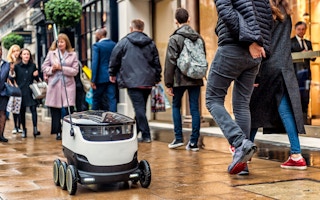British shoppers looked on with surprise and delight as a supermarket worker casually handed over groceries to the newest members of the team - delivery robots.
“Where are you going?” one passer-by asked a white robot, resembling a small fridge on wheels. Another person stopped to wave it goodbye as it rolled off to drop an order to a customer’s door in the central English town of Bedford.
“Robots won’t be a thing of the future, it’s a thing for now,” said Andrew Curtis, head of UK operations at Starship Technologies, the world’s largest maker of delivery robots.
The Estonian robotics firm’s 300 self-driving bots launched in Britain in 2018 and make about 1,000 deliveries in the country each day.
Growing numbers of delivery bots - from pavement-driving pods to flying drones - are being rolled out in urban areas, boosted by a surge of interest during the Covid-19 pandemic.
Robotics firms like Starship, which is headquartered in the United States, say they are creating new jobs and electric bots are greener than car or van drop-offs.
But couriers’ unions fear they bring a looming risk of job losses and worsening conditions for delivery riders and drivers.
“
They’re making autonomous vehicles because they want to get rid of the workers, but they can’t. They need the workers.
Matthew Cole, researcher, Oxford Internet Institute
“Delivery companies already treat their workers like robots so it’s not surprising that they are showing more and more interest in automation,” said Ahmed Uhuru Hafezi, from the Couriers Branch of the Independent Workers’ Union of Great Britain (IWGB).
“Instead of throwing money at new technologies, companies must consult with workers and their unions to ensure that automation does not lead to job losses or burden us with extra responsibilities in what is already a demanding job.”
Robot replacement?
Delivery robots are predicted to generate about $670 million in global revenues by 2030 - up from $70 million in 2022 - according to ABI Research, an international tech analyst firm.
Starship Technologies said its global deliveries tripled in 2021 - its 1,700 self-driving bots made 3 million trips across countries like the United States, Finland, Germany and Estonia.
Its robots are pre-programmed with their delivery route, travelling along pavements and using cameras and sensors to cross roads and avoid obstacles.
If a Starship bot gets stuck, remote human operators in Estonia can control them and set them on their correct course, said Curtis.
FedEx, Amazon, Uber and others have also rolled out pavement-based delivery bots - though Amazon said in October that it was halting live trials of its Scout delivery bot as it was not fully meeting customers’ needs.
Uber is experimenting with using unmanned cars for drop-offs, while Google’s parent firm Alphabet Inc and Amazon have launched drone deliveries.
Many of the programmes are trials or small-scale pilots and are largely based in U.S. urban areas and college campuses.
Moves towards automation have raised concerns among delivery drivers and couriers in the gig economy, many of whom say they already face - and are campaigning against - low pay, gruelling targets and poor work conditions.
“If they can get away with replacing everyone with robots, it makes their life a lot easier because they won’t have any (employee) liabilities,” said Yaseen Aslam, president of the UK-based App Drivers and Couriers Union (ADCU).
“What will happen to all these workers? Where do they go?”
New jobs?
But Starship boss Curtis said robots can bring benefits to society as they can take over some of the menial, poorly-paid tasks currently done by gig workers - and create new jobs for the humans who manage them.
“Some of the bigger competitors that are using courier drivers, they’re not giving workers’ rights, they’re not treating their staff very well,” he said.
“That’s why we think robots are the route forward.”
He believes robots will work alongside human couriers, especially in cities where roads are often too complicated for a bot to navigate. Starship bots are also limited to making deliveries within a roughly three-mile (five-km) radius.
“We’re creating jobs,” Curtis said.
“We’ve almost created a whole sector that wasn’t there before,” he said, referring to dedicated supermarket packing jobs and emerging engineering or robotics roles.
Amazon spokesperson Av Zammit said the online retailer was also boosting jobs and was committed to investing in both robotics and improving workers’ rights.
Amazon had invested $7 billion over the past four years in driver training, safety technology and increased rates of pay for its workers, he said.
The e-commerce giant has been pushing back at efforts to unionise its workforce as labour campaigners make inroads.
Workers at a New York Amazon warehouse in April voted to form the company’s first U.S. union branch. Amazon has contested that result.
Amazon has long been a focus for unions that consider its productivity quotas and above-average warehouse injury rates to be a threat to workers.
Amazon says it offers great benefits and pay, that its goal-setting is fair and it invests heavily in safety.
While unions and firms debate the impact of robots on worker rights and conditions, there are questions over whether self-driving vehicles will ever reach full autonomy.
The head of General Motors subsidiary Cruise told Reuters last month that he thought human overseers might never be phased out from cars, as they offer safety reassurance for users.
“They’re making autonomous vehicles because they want to get rid of the workers, but they can’t,” said Matthew Cole, a gig work researcher at Britain’s Oxford Internet Institute.
“They need the workers.”
This story was published with permission from Thomson Reuters Foundation, the charitable arm of Thomson Reuters, that covers humanitarian news, climate change, resilience, women’s rights, trafficking and property rights. Visit https://www.context.news/.










